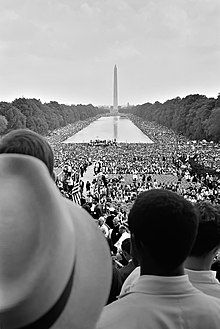March on Washington for Jobs and Freedom - Simple English Wikipedia, the free encyclopedia

The March on Washington for Jobs and Freedom was a rally held on the National Mall in Washington, D.C. on 28 August 1963. It was where Martin Luther King, Jr gave his famous I Have a Dream speech. After the march, the Civil Rights Act of 1964 and the National Voting Rights Act of 1965 were passed. There were over 200,000 people there, both black and white.[1]
Organization and planning[change | change source]
The march was first planned by A. Philip Randolph, who was the president of the Negro American Labor Council, and vice president of the AFL-CIO. He had planned another civil rights march in 1941, but it never happened. However, the threat of the march was a big reason why President Roosevelt wrote Executive Order 8802. This forced equal opportunity in the defense industry, which meant that all workers had to be treated the same, no matter what their race was.
Other leaders of civil rights movement helped Randolph plan the march and spread the word to their members. Some of the most important were James Farmer, (president of the Congress of Racial Equality), John Lewis (president of the Student Nonviolent Coordinating Committee),[2] Martin Luther King, Jr. (president of the Southern Christian Leadership Conference),[2] Roy Wilkins (president of the NAACP),[2] and Whitney Young (president of the National Urban League)..
Protection[change | change source]
Many people were worried for the marchers' safety. Black nationalist leader Malcolm X sent an open telegram to George Lincoln Rockwell, the leader of the Nazi Party in the United States. Malcolm wrote:
| “ | If your present racist agitation against our people there in Alabama causes physical harm to Reverend King or any other black Americans who are only attempting to enjoy their rights as free human beings. That you and your Ku Klux Klan friends will be met with maximum physical retaliation from those of us who are not hand-cuffed by the disarming philosophy of nonviolence and who believe in asserting our right of self-defense - by any means necessary. [3] | ” |
The Washington DC Police department looked for black police officers from around the country to protect King during the march and speeches.[4] They thought the presence of black officers would be more calming if trouble broke out.[4]
References[change | change source]
- ↑ "March on Washington". History?A&E Television Network, LLC. Retrieved 7 March 2016.
- ↑ 2.0 2.1 2.2 "Civil Rights March on Washington, D.C.: Dr. Martin Luther King, Jr., President of the Southern Christian Leadership Conference, and Mathew Ahmann, Executive Director of the National Catholic Conference for Interracial Justice, in a Crowd". World Digital Library. Retrieved 10 February 2013.
- ↑ Strain, Christopher (2005). Pure Fire: Self-Defense as Activism in the Civil Rights Era. University of Georgia Press. pp. 92-93. ISBN 978-0820326870
- ↑ 4.0 4.1 Melanie Eversley. "Witnessing the Dream". USA Today. Retrieved 7 March 2016.


 French
French Deutsch
Deutsch